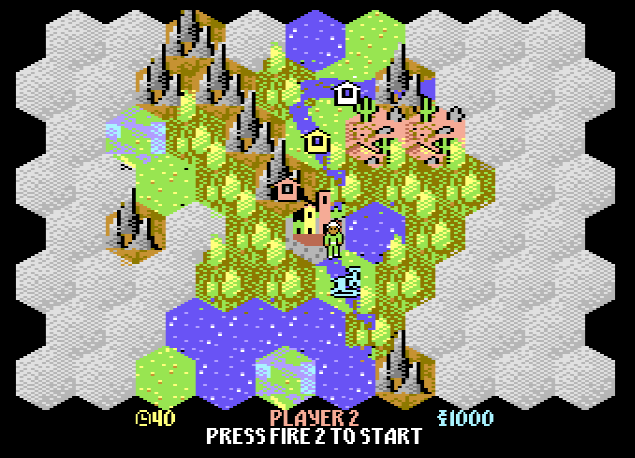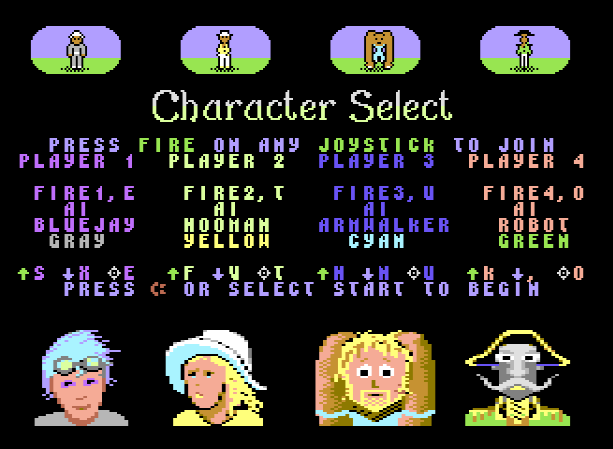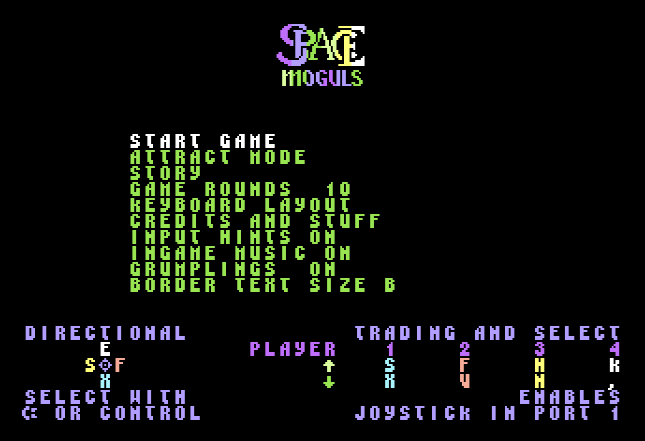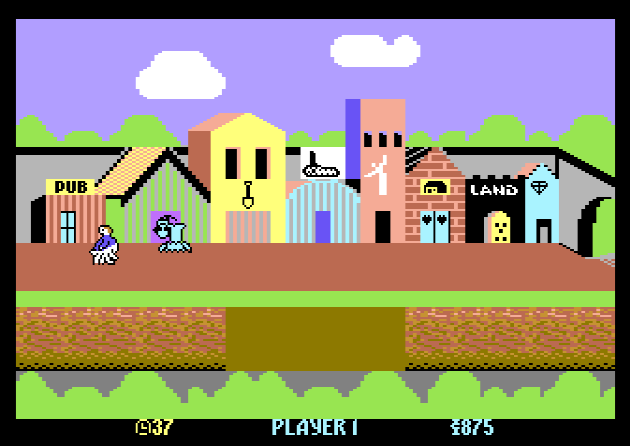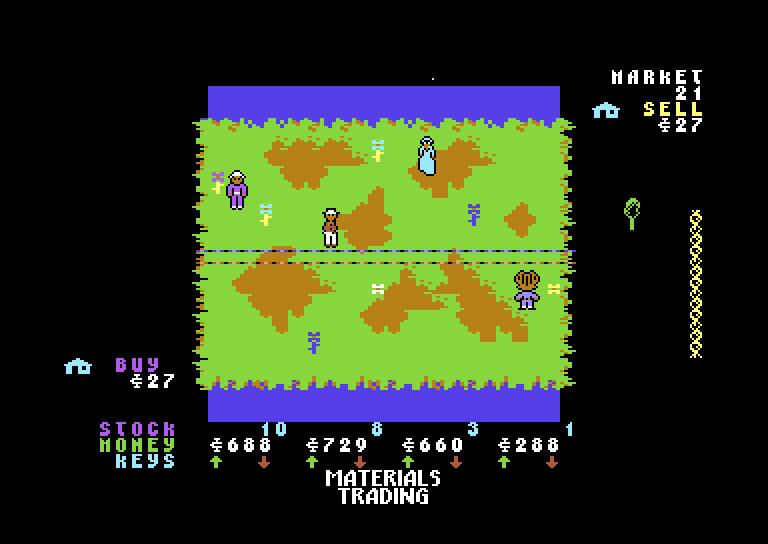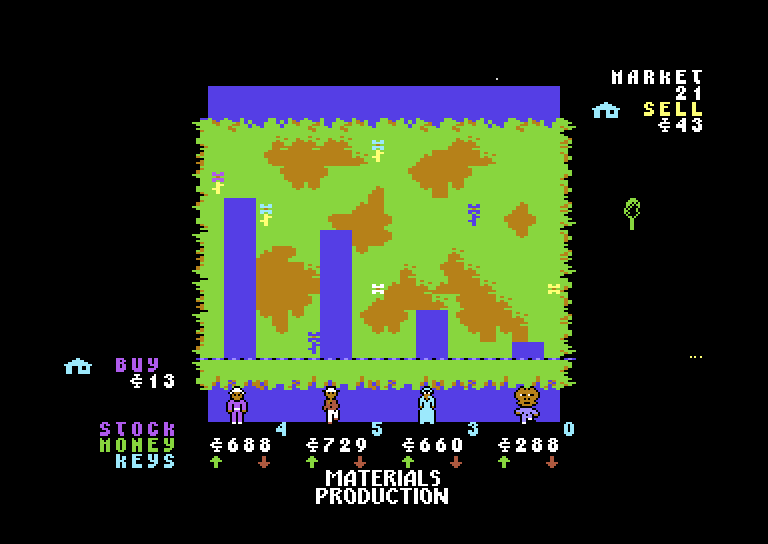Written by World of M.U.L.E. Guest Author Karawane
To discuss this game inspired by M.U.L.E., please use this topic in the WoM forum.
Introduction
Space Moguls is an exceptional M.U.L.E. inspired game for several reasons. First, it has been released in 2018 for the Commodore 64 only, a machine twenty-fife years out of production by then — a daredevil decision if you intend to make a profit. Then, the game is technically phenomenal as it exhausts the capabilities of the Commodore 64 in a way I hardly imagined possible. To a certain extent, this compensates for the old hardware. Moreover, the gameplay is more complex than M.U.L.E. and quite elaborate. In fact, the main audience of Space Moguls would be M.U.L.E. veterans looking for a more demanding challenge. For that matter, the game implements some of M.U.L.E.‘s mechanics that made it such a wonderful multiplayer game and extents them in a reasonable manner to generate (a lot) more variety.
Insights from the development team
I have no particular insights from the development. From what I can read in the manual and on the web, it is quite obvious that the lead programer is strongly dedicated to the Commodore 64 and seems to have satisfied a heartfelt wish by programing this game. But there were a few other sophisticated people involved in the 2-year-development. So, you could compare it to an AA-production. The resulting product certainly feels like it.
How to play this game today
The game can actually be obtained from Protovision on a 5.25“ floppy disk or a cartridge for running it on a real Commodore 64 (or 128). Fortunately, you can also obtain a binary image from the same vendor to run it either on a C64 mini/maxi or –more commonly– through an emulator on modern computers. The VICE emulator works best and even allows for connecting 4 physical joysticks or gamepads which is the nicest way to play it with four real persons. Other emulators sometimes experience problems with the speed synchronisation — I suppose, this is due to exhausting the ultimate technical dodges of the C64.
It is possible to play Space Moguls online, but it is a rather cumbersome way to get there. We found netplay of the CCS64 emulator to be the only to provide a sufficiently stable link. For that, we strongly recommend version 3.9.2 of CCS64 and a dedicated Kaillera server of version 0.86. Other versions, public servers or VICE‘s netplay tend to exhibit varied problems with Space Moguls. If you are up for a game, remember to set all of your local emulator settings (joystick calibration, screen resolution etc.) before you initiate the link. Do not touch settings once the link is established, it will likely bust the synchronisation. Keep in mind that netplay with a C64 emulator is a makeshift not providing the smooth experience of a local game.
Gameplay & gameplay comparison with Atari/Commodore M.U.L.E.
Originally, I have hoped for a deeper understanding of its mechanics before writing this review. I came to the conclusion that there is so much variety in the game that I would probably need years to get a grasp on that. And this is an important piece of information: the game is very versatile, the replaying value is extremely high.
The gameplay of Space Moguls is pretty enhanced compared to M.U.L.E. The basic mechanisms are similar, but the details differ a lot. Similar to M.U.L.E. is the sequence of play: a land grant (and auction), the development, the production, and finally the trading. The user interface is also somewhat alike. You run around the map with your guy moving and installing equipped droids (Space Mogul‘s equivalent to M.U.L.E.s), and run up and down prices during auctions.
The first obvious difference is the map. It consists of 76 plots (roughly twice as many as M.U.L.E.) organised in hexagons instead of squares. There are 9 different land types (in M.U.L.E. there are 3), and a portion of the map is unexplored hidden in fog at the start. Accordingly, the land grant moves in circles from the inner to the outer hexes skipping the unexplored terrain. This sometimes makes it challenging to predict the sequence of the hexes offered. Occasionally, you press the button at the wrong time, especially when competing with others for a certain hex. Among my mates, this has triggered quite a few laughs.
The next difference are the types of equipment to outfit your droid and what you can actually do with its production. Seemingly, the types are similar to those of M.U.L.E.: farming (=food), energy (=energy), mining (=smithore), rare (=crystite), and one additional type materials (≈wood). Now, it starts getting delicate. You need food, energy, ore, and materials to even sustain your further development. If you run low on any of them your progress is severely hampered. The store usually runs low on some items after turn 2, so you better get self-supporting by that time.
The productiveness of land types is rather complex. In fact, my friends and I always keep a printout of page 11 of the manual at hand to quickly check what the plots are good for. And that‘s after having played more than 10 games. I guess, we‘re playing too casually or getting too old for memorizing. But then, the productiveness within a given type is also diverse. For instance, there are lakes that produce plenty of food and others that do not produce food at all. We still havn‘t figured out the mechanism underneath or if that‘s a glitch.
Depending on the development, you can make a lot of money on commodities. But the ultimate cash-cow are rares. As the name suggests, they are rare. Finding rare plots is a venture. Consulting the land office is a shot but often not very helpful. Sometimes, you end up surveying your plots by just trying to harvest rare. Unlike M.U.L.E., the economy of scale does not apply to rare, so plots without deposit do not produce anything for good. Also unlike M.U.L.E., there doesn‘t seem to be a spread around deposits. Hence, it is hard to find rares. If you are lucky, a meteor strike establishes a deposit.
Trading goods is very much like M.U.L.E. There is an auction for every commodity and prices are based on supply and demand. The one thing I am missing in Space Mogul‘s auctions is an indicator of the game turn. Especially in long games, we tend to forget about the turn we are in. This is sometimes crucial to certain decisions. That is why we now operate an analogue calendar aside the display. What an anachronism!
A very nice addition is the configurability. You can choose anything between 4 and 16 turns per game making it possible to play very short or very long games. There are also 4 different planet styles to choose from, with differing ballances of resources. Last but not least, I would like to mention that the music is very nice, in particular the tune during development is really catchy.
In summary, the game is a stunner for anybody liking M.U.L.E. It is still one of the best couch multiplayer games for everybody else. I wish there was a convenient way to play it online. Anyway, the AI is somewhat ok if you want to get into the game without other human players.
Reception
Space Moguls has received little attention, yet, mostly limited to retrogaming websites. Reviews on Youtube and on fansites are quite favourable. Personally, I am sure the game would have been a big success if it had been released in the late 1980s when many people were waiting for a successor to M.U.L.E.
Trivia
The name “Space Moguls” derives from Electronic Art’s working title “Moguls of Mars” for the original M.U.L.E. game in 1983. Later, the Ozark Softscape would convince Trip Hawkins to name it M.U.L.E. Thus, “Space Moguls” is a reminiscence to EA’s original working title.
Downloads, Galleries and Hyperlinks
Box art gallery:
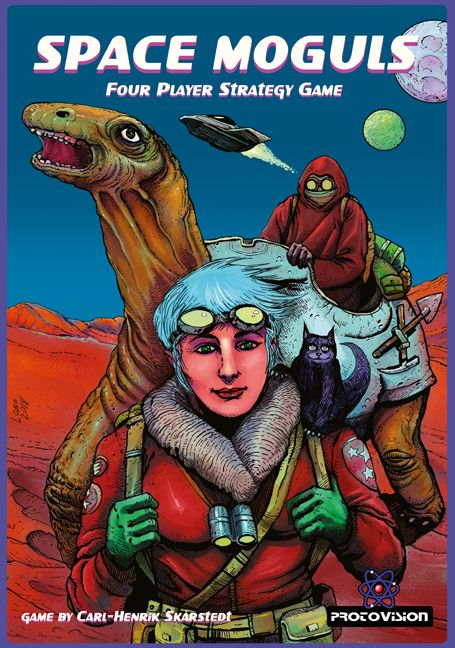
Screenshot gallery:
Hyperlinks:

